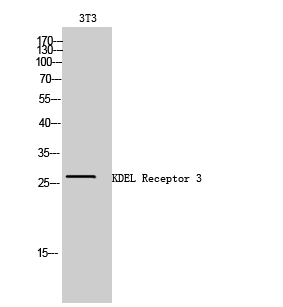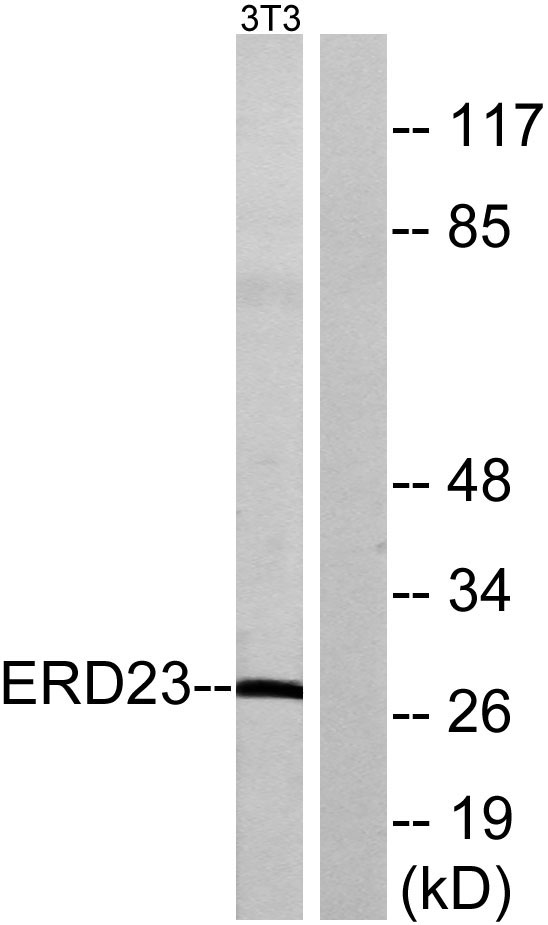KDEL Receptor 3 Polyclonal Antibody
- Catalog No.:YT2463
- Applications:WB;IHC;IF;ELISA
- Reactivity:Human;Mouse
- Target:
- KDEL Receptor 3
- Fields:
- >>Vibrio cholerae infection
- Gene Name:
- KDELR3
- Protein Name:
- ER lumen protein retaining receptor 3
- Human Gene Id:
- 11015
- Human Swiss Prot No:
- O43731
- Mouse Gene Id:
- 105785
- Mouse Swiss Prot No:
- Q8R1L4
- Immunogen:
- The antiserum was produced against synthesized peptide derived from human ERD23. AA range:61-110
- Specificity:
- KDEL Receptor 3 Polyclonal Antibody detects endogenous levels of KDEL Receptor 3 protein.
- Formulation:
- Liquid in PBS containing 50% glycerol, 0.5% BSA and 0.02% sodium azide.
- Source:
- Polyclonal, Rabbit,IgG
- Dilution:
- WB 1:500 - 1:2000. IHC 1:100 - 1:300. ELISA: 1:20000.. IF 1:50-200
- Purification:
- The antibody was affinity-purified from rabbit antiserum by affinity-chromatography using epitope-specific immunogen.
- Concentration:
- 1 mg/ml
- Storage Stability:
- -15°C to -25°C/1 year(Do not lower than -25°C)
- Other Name:
- KDELR3;ER lumen protein retaining receptor 3;KDEL endoplasmic reticulum protein retention receptor 3;KDEL receptor 3
- Observed Band(KD):
- 28kD
- Background:
- KDEL endoplasmic reticulum protein retention receptor 3(KDELR3) Homo sapiens This gene encodes a member of the KDEL endoplasmic reticulum protein retention receptor family. Retention of resident soluble proteins in the lumen of the endoplasmic reticulum (ER) is achieved in both yeast and animal cells by their continual retrieval from the cis-Golgi, or a pre-Golgi compartment. Sorting of these proteins is dependent on a C-terminal tetrapeptide signal, usually lys-asp-glu-leu (KDEL) in animal cells, and his-asp-glu-leu (HDEL) in S. cerevisiae. This process is mediated by a receptor that recognizes, and binds the tetrapeptide-containing protein, and returns it to the ER. In yeast, the sorting receptor encoded by a single gene, ERD2, is a seven-transmembrane protein. Unlike yeast, several human homologs of the ERD2 gene, constituting the KDEL receptor gene family, have been described. KDELR3 was the third member of the family to be identified. Alt
- Function:
- function:Required for the retention of luminal endoplasmic reticulum proteins. Determines the specificity of the luminal ER protein retention system. Also required for normal vesicular traffic through the Golgi. This receptor recognizes K-D-E-L.,similarity:Belongs to the ERD2 family.,
- Subcellular Location:
- Endoplasmic reticulum membrane ; Multi-pass membrane protein . Golgi apparatus membrane ; Multi-pass membrane protein . Cytoplasmic vesicle, COPI-coated vesicle membrane ; Multi-pass membrane protein . Localized in the Golgi in the absence of bound proteins with the sequence motif K-D-E-L. Trafficks back to the endoplasmic reticulum together with cargo proteins containing the sequence motif K-D-E-L. .
- Expression:
- Cervix,Kidney,Stomach,Synovial cell,
- June 19-2018
- WESTERN IMMUNOBLOTTING PROTOCOL
- June 19-2018
- IMMUNOHISTOCHEMISTRY-PARAFFIN PROTOCOL
- June 19-2018
- IMMUNOFLUORESCENCE PROTOCOL
- September 08-2020
- FLOW-CYTOMEYRT-PROTOCOL
- May 20-2022
- Cell-Based ELISA│解您多样本WB检测之困扰
- July 13-2018
- CELL-BASED-ELISA-PROTOCOL-FOR-ACETYL-PROTEIN
- July 13-2018
- CELL-BASED-ELISA-PROTOCOL-FOR-PHOSPHO-PROTEIN
- July 13-2018
- Antibody-FAQs
- Products Images

- Western Blot analysis of 3T3 cells using KDEL Receptor 3 Polyclonal Antibody

- Western blot analysis of lysates from NIH/3T3 cells, using ERD23 Antibody. The lane on the right is blocked with the synthesized peptide.



